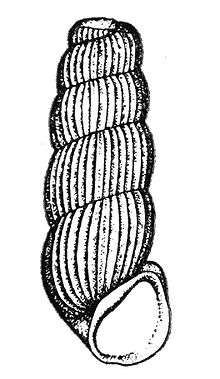Truncatellidae
Truncatellidae, common name the "looping snails", is a family of small amphibious snails, with gills and an operculum, semi-marine gastropod mollusks or micromollusks.
| Truncatellidae | |
|---|---|
| Two live individuals of Truncatella subcylindrica: a juvenile on the left, and an adult on the right | |
| Scientific classification | |
| Kingdom: | |
| Phylum: | |
| Class: | |
| (unranked): | |
| Superfamily: | |
| Family: | Truncatellidae Gray, 1840[1] |
Shell description

This family of snails have small shells which lose their apical whorls as they continue to grow, giving the shells a truncated and cylindrical appearance.
Subfamilies
The family Truncatellidae consists of two subfamilies (according to the taxonomy of the Gastropoda by Bouchet & Rocroi, 2005):[2]
- subfamily Truncatellinae Gray, 1840
- subfamily Geomelaniinae Kobelt & Möllendorff, 1897[3]
Genera
Genera within the family Truncatellidae include:
Truncatellinae
- Truncatella Risso, 1826[4] - type genus of the family Truncatellidae[2]
Geomelaniinae
- Geomelania L. Pfeiffer, 1845 - type genus of the subfamily Geomelaniinae[2]
subfamily ?
Habitat
Snails in this family are found in marine coastal environments, near or just above the high tide line on stones and pebbles, fine sediments and decomposing vegetation.
Life cycle
The sexes are separate. Fertilized eggs are laid as egg capsules, which are attached to detritus.
References
- Gray (1840). Synopsis of the contents of the British Museum ed. 42: 117, 148.
- Bouchet, Philippe; Rocroi, Jean-Pierre; Frýda, Jiri; Hausdorf, Bernard; Ponder, Winston; Valdés, Ángel & Warén, Anders (2005). "Classification and nomenclator of gastropod families". Malacologia. Hackenheim, Germany: ConchBooks. 47 (1–2): 1–397. ISBN 3-925919-72-4. ISSN 0076-2997.
- Kobelt & Möllendorff (1897). Nachrichtsblatt der Deutschen Malakozoologischen Gesellschaft 29(5-6): 74.
- "Mollusca" Archived 2012-06-26 at the Wayback Machine. Diversidad Biológica Cubana, accessed 23 March 2011.